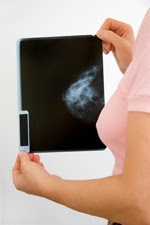Pure breast health information - Limitations of mammograms. A mammogram cannot prove that an abnormal area is cancer. To confirm whether cancer is present, a small amount of tissue must be removed and looked at under a microscope. Pure breast health information - Limitations of mammograms. (more : Doctor Looks for on Your Mammogram - Cancer Society Recommendations for Breast Cancer)
This procedure, called a biopsy, is described in the section, "How is breast cancer diagnosed?"
You should also be aware that mammograms are done to find breast cancer that cannot be felt. If you have a breast lump, you should have it checked by your doctor and consider having it biopsied even if your mammogram result is normal.
For some women, such as those with breast implants, additional pictures may be needed. Breast implants make it harder to see breast tissue on standard mammograms, but additional x-ray pictures with implant displacement and compression views can be used to more completely examine the breast tissue.
Mammograms are not perfect at finding breast cancer. They do not work as well in younger women, usually because their breasts are dense, and can hide a tumor. This may also be true for pregnant women and women who are breast-feeding. Since most breast cancers occur in older women, this is usually not a major concern.
However, this can be a problem for young women who are at high risk for breast cancer (due to gene mutations, a strong family history of breast cancer, or other factors) because they often develop breast cancer at a younger age. For this reason, the American Cancer Society recommends MRI scans in addition to mammograms for screening in these women. (MRI scans are described below.)
For more information on these tests, also see the section, "How is breast cancer diagnosed?" and our document, Mammograms and Other Breast Imaging Procedures.
This procedure, called a biopsy, is described in the section, "How is breast cancer diagnosed?"
You should also be aware that mammograms are done to find breast cancer that cannot be felt. If you have a breast lump, you should have it checked by your doctor and consider having it biopsied even if your mammogram result is normal.
For some women, such as those with breast implants, additional pictures may be needed. Breast implants make it harder to see breast tissue on standard mammograms, but additional x-ray pictures with implant displacement and compression views can be used to more completely examine the breast tissue.
Mammograms are not perfect at finding breast cancer. They do not work as well in younger women, usually because their breasts are dense, and can hide a tumor. This may also be true for pregnant women and women who are breast-feeding. Since most breast cancers occur in older women, this is usually not a major concern.
However, this can be a problem for young women who are at high risk for breast cancer (due to gene mutations, a strong family history of breast cancer, or other factors) because they often develop breast cancer at a younger age. For this reason, the American Cancer Society recommends MRI scans in addition to mammograms for screening in these women. (MRI scans are described below.)
For more information on these tests, also see the section, "How is breast cancer diagnosed?" and our document, Mammograms and Other Breast Imaging Procedures.

No comments:
Post a Comment
Please live good comment :)